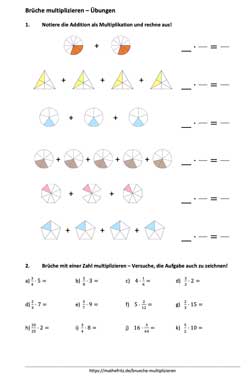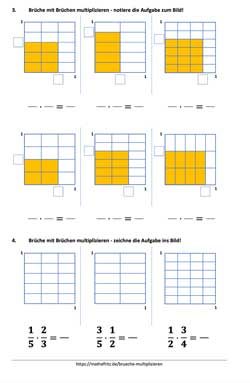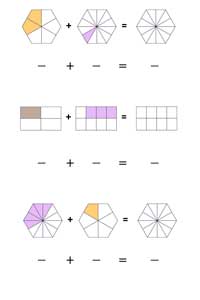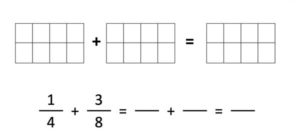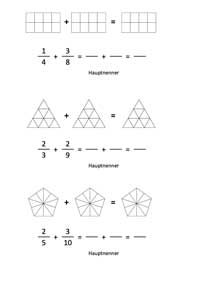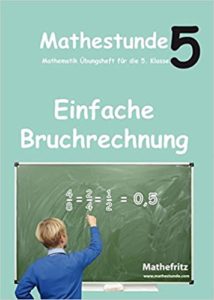Multiplying fractions - Learning fraction multiplication
Multiplying fractions - this is how it works
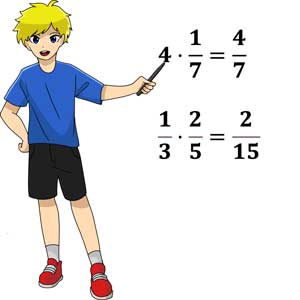
Multiplying fractions - how does it work?
To do this, we first multiply fractions by whole numbers. That is still simple.
Then we multiply fractions by fractions.
Once we have understood these arithmetic rules, we practise larger arithmetic expressions with fractions, brackets, plus, minus and multiplication signs.
Multiply fractions by whole number
Multiplying fractions by whole numbers - Rule | Definition
You multiply a fraction by a whole number by multiplying the numerator of the fraction by the number and leaving the denominator of the fraction unchanged!
You can also make this clear to yourself by understanding multiplication by a number as multiple addition!

Adding fractions like multiplication by a whole number
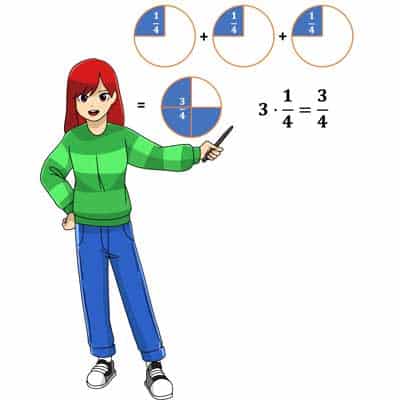
Fractions Multiplication Tasks Worksheet & Online Exercise

to print out
Fractions Multiplication Tasks PDF
A worksheet for the following online exercises. Simply print it out and practise on paper or fill it in on your tablet with a pen.
As a test or class work for an easy introduction to fractions! Are you fit?
The online exercises will be created very soon!
online exercise - multiplying fractions and fractions
Fractions Multiplication Tasks PDF
Two pages of worksheets for the following online exercises. Simply print them out and practise on paper or fill them in on your tablet with a pen.
As a test or class work for an easy introduction to fractions! Are you fit?

to print out
The online exercises will be created very soon!
Here you can still see the exercises on the page Adding and subtracting fractions!
Multiplying fractions tasks - exercise (1) Fractions with equal denominators
Enter only the numerator of the fraction in the empty field as the result!

Multiply fractions - calculate larger arithmetic expressions
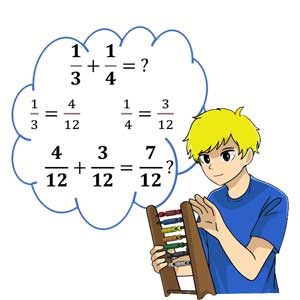
are added by bringing the fractions
to the same denominator.
Then add the numerators!
So you can add and subtract fractions if they do NOT have the same denominator (are not of the same name).
Fractions with different denominators can only be added or subtracted when the denominators are the same. To do this, you have to reduce and/or expand the fractions until they have the same denominator.
The common denominator (main denominator) results from the smallest common multiple of all denominators involved!
Examples:
(1) \(\frac{1}{3} +\frac{1}{4} = \frac{1\cdot 4}{3 \cdot 4} + \frac{1 \cdot 3}{4 \cdot 3} = \frac{4}{12} +\frac{3}{12} = \frac{7}{12} \)
(2) \(\frac{2}{9} +\frac{1}{6} = \frac{2\cdot 2}{9 \cdot 2} + \frac{1 \cdot 3}{6 \cdot 3} = \frac{4}{18} +\frac{3}{18} = \frac{7}{18} \)
You can also find more theory about fractions on Wikipedia!
Normally you do this in fractions grade 5.
Exercise (2) - Find the same denominator of 2 fractions and then add the fractions.
Add the missing numbers to the numerator of the fraction. Look carefully. The common denominator of the fractions is already there!
Exercise (3) - Write down the task and then work it out!
Add the missing numbers to the numerator and denominator of the fraction.

Addition, find tasks
to print out
Worksheets multiply simple fractions
The tasks from the exercises type (III) as PDF for printing:

